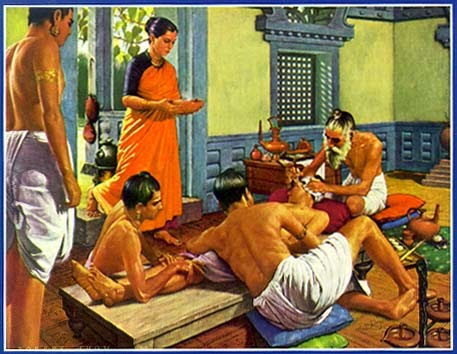Medical Science was surprising advanced in ancient times in India. Specifically these advances were in the areas of plastic surgery, extraction of catracts, dental surgery, etc., These are not just tall claims. There is documentary evidence to prove the existence of these practices.
The Aitareya Upanishad (1-1-4) states how the organs develop in the foetus. It says that first the mouth comes into existence, then the nostrils, then eyes, then ears, then heart, then navel, then the penis. The same order of development is given in the Bhagawata. It is surprising that the same order is discovered by the modern science, recently.
The Bhagawata (3/31/3) states that the head of the foetus is formed at the end of the first month. This appears true in the light of the modern investigations in embryology. The Bhagawata gives further information that as soon as the nostrils develop there appears Prana and vocal chords also develop. Modern science has the same opinion.
The Bhagawata (2/10, 3/6,26) clearly tells that foetal heart begins working in the second month of pregnancy. In December 1972, nodern scientists discovered that the foetal heart begins working during 7th and 8th weeks of pregnancy.

The Bhagawata (2/1022, 3/26/55) states that ears are responsible for recognizing the directions. Here the directions are personal e.g. in front, at back, to the right or left, up or down. These six directions are original, personal and they are sensed by the ears.
The Bhagawata is composed around 1650 years BC and the Aitareya is composed around 6000 years BC. But the statements recorded in them are found true by the modern science during 1935 AD when Ross and Tait wrote an essay showing that the Labyrinth or the vestibular apparatus situated in the internal ear recognise the directions. Is it not miraculous that the discovery of 1935 is recorded in scriptures, thousands of years old? It proves that the medical science was well advanced during the ancient era in India.
Surgery was far advanced in the Rigveda era, therefore it is recorded that Queen Vishpala was fitted with an artificial lower limb when it was severed in a battle.(Rg.1-116-15), and was made fit, again, to fight in a battle. Modern surgeons do fit an artificial limb; but a patient takes about a year to walk with it, and he cannot take part in a battle again.
There is a surgical concept of transplant operations in India since the Rigveda. One sage Daddhyanga got some disease in his head. To cure it Ashvinau took his head away and in its place implanted a head of a horse for a while.(Rg.1-116-12). After repairing his human head they replaced it again removing the horse’s head. The sage became normal. One may laugh at this statement because at present no such operation on head or brain is possible. But is it really impossible? At present, heart can be transplanted. During an operation on heart, it is totally stopped by freezing and with the help of Heart-lung machine circulation is maintained and after correcting the defect in the heart it is connected to the circulation, removing the heart-lung machine. In the same way, was not it possible to implant a horse’s head in place of human head to maintain the give and take of sensory and motor impulses and to continue the vital functions, which are similar in man and horse? Serum of horse is tolerated by humans, then nervous tissue may also be tolerated. We have to experiment on this technique.

Because of this Vedic tradition of surgery, Sushruta could develop plastic surgery to repair severed or deformed nose – Rhinoplasty. He used a flap of skin from forehead to repair nose. In 1957 Prof. Vartak was working as a surgeon in S.T.R. Hospital and Tilak Ayurvedic college, where he read Sushruta Samhita. He suggested to use that old technique but it was neglected. Twelve years later one German surgeon read Sushruta and operated accordingly with good results. Since then all the surgeons are using the same technique thinking that it is a German technique.
Shrimad Bhagawata (9-3-27 to 36) gives a story that king Kakudmi went with his daughter Revati to the Brahmaloka to find her a husband. Brahmadewa told him that in some seconds of his presence in that Loka (solar system) 27 Tetra-Yugas (About 216 years) on the Earth had passed and that there was nobody from his family alive. Brahmadewa advised him to return and wed Rewati to Balarama, who had then born. Accordingly Kakudmi returned with Rewati and gave her to Balarama in marriage. The important scientific points in this story are thus:
The two went on another solar system leaving the Earth. They spent some seconds there, but during that seconds 27 Tetra-Yugas passed on the Earth. It shows that Sage Vyasa knew that the time scales are different on different planets or solar systems. This is agreed to by the science now. They returned after 216 years but still Rewati was in puberty and her father was alive. Aging factor had stopped working on them. After their return, they could not see their descendents, so at least 216 years had passed. They had defeated the death. Their life had extended. The only cause attributed is the space travel to another solar system with tremendous speed. One may not agree that the two actually traveled to some other Loka; but one has to accept the theoretical knowledge present in the story, which is the same as that propounded by Einstein in the 20th century, that if some body travels with a great speed to another place in the space, its or his life extends. Even in the present world nobody has traveled to another solar system, even then the theory is accepted by science.
The Prashnopanishad (3/8) states that Deity present in the Earth attracts Apana of a living person and helps its action. Adi Shankaracharya comments on this verse that if the famous Goddess of the Earth did not help Apana and did not hold down by its attraction force or Gravitation, then this physical body would have floated in the space or fallen anywhere. Thus the Prashnopanishad of 6000 years B.C. and Shankaracharya of, at least, 800 A.D. knew the gravitation force of the Earth much before Newton of 18th century A.D. This proves that the gravitational force of the Earth was known to the Indians 7000 years earlier than Newton.
Thus it seems that medical and biological sciences were very well developed along with other physical sciences in ancient India and all that knowledge is stored in our Shastras. We have to decifer their meanings on the basis of modern science. Scientists should do this work because they are well versed with the present scientific knowledge, which is helpful to expose the knowledge concealed in the Shastras. If our scientists do so, we can progress much in the scientific field.
Source: Medical Science from ancient Indian Shastras. by Dr. P.V. Vartak



